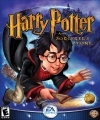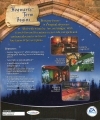Harry Potter and the Sorcerer's Stone
First posted on 01 August 2003. Last updated on 11 August 2009.
When the movie Harry Potter and the Sorcerer's Stone first arrives in theatres, I have decided to pass on it. It seems then that I must be among the handful of people left in this universe who have never read Harry Potter. When I see the movie on video later on, I immediately start reading the books and devour them in a matter of days. The single thought that keeps going through my head is what a great game this can make. The thought of exploring Hogwarts and playing a game of Quidditch seems like a dream game. With the huge fan base of Harry Potter, it is just a matter of time before such a game hits the shelves—and what a game it is, if you are able to overlook some minor issues along the way.
For the few who are not familiar with the history of Harry Potter, here is a capsule summary. Harry Potter is a young orphan living with his aunt, uncle, and bratty cousin. He is told that his parents have died in a car accident long ago and he is sent to live with his only living relatives. Then, on his 13th birthday, he is invited to attend the Hogwarts School of Magic. It is there Harry discovers that his parents are wizards and they actually have been killed by an evil wizard by the name of Voldemort. Voldemort, unable to kill Harry at the time, has destroyed himself in the process. The only souvenir of this encounter is a lightning bolt shaped scar Harry now spots on his forehead.
Both the game and the movie are based on the first book in the Harry Potter series, Harry Potter and the Philosopher's Stone, by JK Rowling. The titles are later changed to Harry Potter and the Sorcerer's Stone due to copyright issues between British publisher Bloomsbury Publishing and US publisher Scholastic. The game takes place in Harry's first year at Hogwarts. There, Harry investigates the mysterious Sorcerer's Stone—an item that grants immortality to whoever is in possession of it—an item that can also grant Voldemort the power to return and exact his revenge.
This game is meant for younger children, and it shows from the beginning in the way the story is handled. The introduction to the game reveals the back-story in a storybook form, before Harry is sent off to Hogwarts where the game starts. Yet, perhaps so as to not scare the younger players, the character of Voldemort is not mentioned in the introduction, or for the most part, throughout the game at all until the very end. It seems odd to remove the actual villain of the story from most of the game, but it takes out some of the scarier chills which I suppose has been the intent.
It is obvious from the way that the game story is told that the developer is relying on children to be already familiar the story before they play the game. Sections of the book or movie are cut from the game and are just explained in single sentence tidbits that mean nothing to someone who has neither read the book nor seen the movie. This is all done in order to move the game forward with another arcade sequence or introduction of a new spell or gadget. This is especially irksome in a particular spot where I go from a lush, green outdoor area to a cut scene which informs me that it is now winter so I can get my Christmas present that is needed for the next area.
The game for the most part is split into 3 recurring sections—watch a cut-scene that explains the story, learn a spell or gain an item of interest, and work through an arcade sequence that pertains to the spell or cut-scene. This sequence is interspersed with periods of free exploration time to explore the school for hidden areas. It has a tendency to become formulaic, but it is still a blast to work through each area looking for hidden places along the way.
The sound in this game is wonderful and fits the movie perfectly. In contrast, Harry can get repetitive and a little annoying as the game progresses. When casting a spell, Harry shouts out its name as he casts. This is wonderful in the beginning of the game whereby it adds a lot of atmosphere. However, when you are casting spells on everything trying to find the hidden areas, Harry screaming "Flipendo" over and over can get tiresome quickly over time.
All the graphics rendered in this game are in low resolution only, though they are made up for with great texture mapping. For the most parts, this works well until the characters start to speak. The first time Ron Weasly runs up to me, I am amazed at the texture mapped face with its great resemblance to the actor Rupert Grint who plays Ron in the movie. However, when he starts talking and his arms moves expressively, his head merely bobbles up and down and his mouth does not move at all. This pulls me right out of the game and is a hard thing to get used to watching, especially with the amount of cut scenes this game has. Other than this annoyance, I enjoy the graphics in the game immensely. Suits of armor turn to look at you, ghosts fly by and through you, and the school is full of hidden surprises behind mirrors, paintings, and statues.
Gameplay is a mixed bag for me. I am more of a traditional adventure game player and not a huge fan of jumping puzzles and arcade action. On the other hand, those who do not mind a hybrid adventure/action game can feel right at home with this game. A particular sequence in which Harry, in his invisibility cloak sneaking through a set of hallways and libraries while jumping over bookcases and trying to get past the groundskeeper and his cat who are looking for him, has me excited and sitting on the edge of my seat.
The puzzle sequences for the game consist mainly of working your way through a maze like area of some sort, such as a garden, library, or cave, while using your spell arsenal to defeat enemies and achieve the main objective by making it to the end of the area you are in. On your way, you also collect glowing stars, Bernie Bott's Every Flavor Beans, and Wizard Cards. Notwithstanding these extra tasks, most of Harry's time are spent on jumping and climbing to reach the next switch to trigger the next door to the next area to get to the next switch and so on. Surprisingly, this routine does not seem to get tired. This is because the beans you collect can be traded for more Wizard Cards, and a big source of replay value in this game is working your way through again to try and get another Wizard Card the next time through. I have already played through the game 3 times and still have not found all of the cards. Perhaps the fourth time is the charm!
The puzzles and arcade sequences can be hard, but a couple of options save it from being too difficult or tedious for children and traditional adventure gamers. First is the option to turn on jumping automatically which can be a huge help in some of the longer sequences where a missed jump means a long trek back through the area. The game is set up so that Harry tries over and over again from his last save point if he fails. So as not to scare children, Harry does not die when his lightning bolt shaped energy meter is depleted. He merely faints, and then wakes up at the last save point.
Reflex impaired gamers are well advised that the game only allows saving at the end of arcade sequences and challenges and at predetermined save points. This means a single wrong step may lead you to repeat an entire sequence again. When you move back to the previous save point, your health remains the same as when you first save the game. For example, I have to play my second Quidditch match for almost an hour because my last save happens when I have been low on health. I have to struggle to get through the sequence without fainting near the beginning over and over again. This also means sitting through repeated cut scenes since there is no way to escape out of them until they are done.
There are a lot more highs in this game than I originally expect to see in a kid's game. The graphics and environment are a blast to play through. Trying to find every hidden area and Wizard Card has kept me playing for a long time. The characters walk me through every aspect of playing the game and then let me test it out, so confusion is kept to a minimum—a wonderful feature for the younger gamers. Most of the lows in this game are not even remotely enough to not recommend the game to kids and fans of the series. I really like to see the game stick more to the book, but considering that most children know the story already inside and out before playing the game, I guess this is not a huge problem. The console saving system is a problem for me, but with more and more console gamers playing today, this most likely does not stop these gamers from enjoying this title. Here is a note to the developer for the sequel—please make character's mouths move when they talk, otherwise it is just weird!
Harry Potter and the Sorcerer's Stone is a wonderful game. Children and fans of Harry Potter are bounded to love the opportunity to explore the Hogwarts School of Magic or play a game of Quidditch, as well as the hunt for that last Wizard Card and Every Flavor Bean. Overall, I can recommend this game without hesitation to any gamer, especially if that person is willing to look past a few minor gameplay issues.






